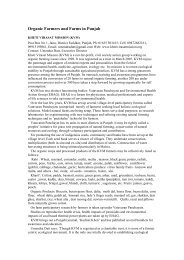Western Ghats Kokum Foundation - Organic Farming Association of ...
Western Ghats Kokum Foundation - Organic Farming Association of ...
Western Ghats Kokum Foundation - Organic Farming Association of ...
Create successful ePaper yourself
Turn your PDF publications into a flip-book with our unique Google optimized e-Paper software.
An average kokum tree bears hundreds <strong>of</strong> fruits during summer. When they are<br />
tender, they are green in color. As they ripen, they get the beautiful purple color. The fruits<br />
are plucked when they are ripe. The outer purple skin and the inner seeds are sun-dried<br />
separately. The skin, bhirnda sol, is used in cooking as a souring agent and the seeds are<br />
used to make bhirndel tel (kokum oil/butter).<br />
Our favorite way <strong>of</strong> enjoying the ripe fruit was to eat it with salt. Carefully take out<br />
the tiny cap <strong>of</strong> the fruit, which would leave a hole on the surface. Then with the help <strong>of</strong> a<br />
toothpick, push some salt crystals in the hole. Insert the toothpick in the hole and rotate it<br />
few times to mix the salt with the seeds <strong>of</strong> the fruit. Now suck the juices through the hole.<br />
Ahhh.. it’s heaven. Only those who have actually tasted this can understand the sheer<br />
pleasure it gives. Once all the juices are done, break the skin into two and pop the seeds one<br />
by one in the mouth. Discard the seeds. This was our favorite fruit to eat (only after mango)<br />
during summer vacations.<br />
The most popular dish prepared with fresh kokum is the Sol-kadi or Soul Curry. A<br />
sweet, spicy and sour drink with mustard seasoning. As kokum has cooling effects on the<br />
body, this is the perfect drink for hot summers.<br />
Bottled/canned kokum syrup juice or agal is available in many shops in Goa which<br />
acts as replacement for the fresh fruit to make the kadi. Another version that is very popular<br />
is sol kadi, prepared with fresh coconut milk. Tetrapaks <strong>of</strong> kokum juice and carbonate<br />
kokum soda is now readily available.<br />
The skin <strong>of</strong> the fruit – which is normally sold as ‘kokum’ is sun dried in large<br />
quantities to be used when the fresh kokum is not available.<br />
Some salt crystals are added to the dried kokum, which acts as a preservative. As<br />
days pass, the dark purple skin turns black. When soaked in water for some time, the skin<br />
leaves beautiful purple color. This has many medicinal properties. The skin is soaked in<br />
water for sometime and the purple colored water is given to the patients suffering from<br />
‘pitta‘.<br />
Sometimes the fruit is mixed with sugar and sun dried. The juice that comes out <strong>of</strong> it<br />
is preserved to make kokum juice.<br />
The seeds are sun dried to make kokum butter (bhirndel tel). The outer black shells<br />
<strong>of</strong> the seeds are peeled and the inner white colored seeds are chopped and ground into fine<br />
paste. Then they are cooked and dried to get the butter. The butter retains its solid shape at<br />
room temperature. When needed, it is held near a flame to melt it. This melted oil is applied<br />
to cracked heels and dried skin, which acts as a very effective moisturizer. Before we were<br />
introduced to different moisturizer brands, we used this as a moisturizer. Even now, we use<br />
it frequently for cracked heels.<br />
12<br />
Resource Book on <strong>Kokum</strong> (Garcinia indica Choisy)<br />
<strong>Western</strong> <strong>Ghats</strong> <strong>Kokum</strong> <strong>Foundation</strong>, Panaji - Goa





